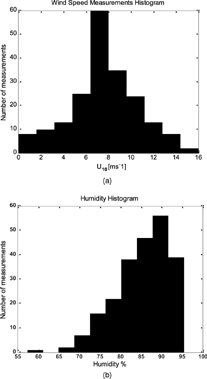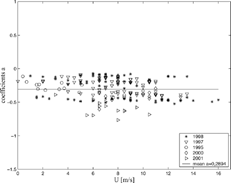This paper presents the data obtained during the polar research cruises of the r/v Oceania in 1995–2001. The aerosol size distributions were measured using the laser particle counter CSASP-100-HV-SP. The size spectral density between diameters 0.5–15 μ m was found to fit the following form: dN/dr = n(2 r) = exp (a2 r + b) , where: a = − 0.29 and b are functions of wind speed. Additionally, poor precision of the sea spray emission determination using only the aerosol concentration data measured at one altitude was confirmed.
1. INTRODUCTION
Studies of marine aerosol production and transport are important for many earth sciences such as cloud physics, atmospheric optics, environmental pollution studies, and interaction between ocean and atmosphere. It was one of the reasons for the growth in the number of research programs dealing with marine aerosols. Many authors focused on size distribution of marine aerosols (Wiedensohler et al. 1997; CitationKoponen et al. 2000). Despite many publications about marine aerosols, our knowledge of sea spray emission is still far from sufficient.
Without precise determination of the flux of drop emission from the sea surface, it is not possible to ascertain whether sea spray affects the air-sea fluxes of heat and latent heat (CitationBortkovskij 1972, Citation1987; CitationBorisenkov 1973; CitationPetelski 1986, Citation1996, CitationMestayer et al. 1989; Fairall et al. 1990; CitationAndreas 1992; CitationEdson et al. 1996).
Mechanisms of sea salt particle transport from the sea surface to the atmosphere is well understood thanks to efforts of many researchers, such as Blanchard (1954, 1963, 1989) and CitationCipriano et al. (1983). Emission of drops from whitecaps and sea foam is quite well known thanks to laboratory studies of CitationWu (1973) and CitationMonahan et al. (1982). However, the problem of parameterization of aerosol emission from the sea surface has not been solved yet.
The aim of this study is to analyze concentration of aerosol particles and size distributions in the near water layer in the open sea area and to analyze the impact of sea spray emission. The analyses of measured data of concentration of aerosol in the marine boundary layer above the open ocean is presented. The discussion whether such results are sufficient to estimate the emission source function is also given.
Small particles, which can be distributed over long distances and therefore their concentration may not result from local emissions, this article focuses on aerosol particles larger than 0.5 μ m, which have dominating impact on exchange of mass, momentum, and energy between sea and the atmosphere.
This size range covers only part of one mode and thus a simple exponential distribution was applied:
The author's data show that this function describes sufficiently well the size distribution of aerosol particles in this size range. A similar distribution was used by Citationvan Eijk and de Leeuw (1992) in their aerosol studies in the North Sea region. Also, CitationZielinski et al.(1999) and CitationZielinski (2004) used similar function to model optical properties of aerosols using lidar methods over coastal areas.
2. AREA AND MEASUREMENT METHODS
Data were collected during the Arctic cruises of r/v Oceania to Arctic Seas (Norwegian Sea, Greenland Sea, Barents Sea) in 1995–2001. The cruise routes are shown in . Arctic Seas are very suitable for marine aerosol investigations as an advection from land occurs there less frequently than in other European seas.
A laser particle counter CSASP-100-HV was used in measurements. The CSASP-100-HV produced by the Particle Measurement Systems (Boulder, CO, USA) is an optical spectrometer of aerosol measurements using the He-Ne laser. It measures particles of sizes from 0.5–48 μ m at 36 size ranges.
FIG. 1 Locations of the hydrographic measurement stations during the cruises of the r/v “Oceania” in the Norwegian and Greenland Seas in summer periods in 1995–2001.
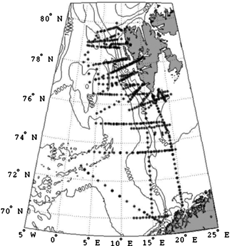
This type of laser counters has been a standard device in numerous experiments (Citationde Leeuw et al. 2000; CitationJensen et al. 2001; CitationGathman 1983; CitationZielinski 2004). Significant differences in size distribution measurements may occur between different optical instruments (CitationJensen et al. 2001). The authors always used the very same counter, which was calibrated before and after the experiments as well as in 2000 by the manufacturer. Additionally, the authors have calibrated the laser counter with FLS-12 lidar system during a number of joint measurements (CitationZielinski 2004). The calibration results indicated a very stable performance of the counter.
The measurements using the laser particle counter were made onboard r/v Oceania, while the ship was drifting at hydrological stations. The laser counter was located at an altitude of 3 m a.s.l. and one meter above the deck. The counter inlet was always placed horizontally facing the wind. During the measurements the author used only the inlet which was installed and tested by the manufacturer. The 18 cm long inlet is a convex tube with 2.3:1 acceleration of the airflow.
Air temperature (Tp) and humidity were determined from measurements of wet- and dry-bulb air temperatures with a sling (Assman) psychrometer. The recordings were made at the same elevation above sea level as the aerosol measurements. presents a histogram of relative humidity, while wind speed U 10 values are presented in .
The wind speed at 10 m a.s.l. (U 10) was measured with a cup anemometer. Ship's course, speed, and position from the GPS system were also recorded.
Measurements were carried out during the summer period: June, July, and August. At this time of the year storms are rare in this region. Hence the results presented below were collected only at wind velocities ranging from 0 to 17 m/s.
3. RESULTS
To eliminate humidity impact, the data sets were limited only to those when humidity was lower than 95%. The following formula for the limitation of the size distribution to humidity 80% has been used:
This formula introduced by CitationFitzgerald (1975) has been used widely. All the results discussed below were corrected to 80% humidity using formula (1).
The examples of the particle counter measurements are shown in . The size distributions n(2r) presented in this picture refer to the particles from the size range of diameters [0.5, 15 μ m]. Particles larger than 15 μ m were measured sporadically, due to relatively short measurement series. Thus the analyses were limited to aerosol particles from size range of diameters [0.5, 15 μ m]. Most of size distributions in this size range could be approximated by exponential functions. shows one of the measured n(2r) distributions, with one vertical axis in a lognormal scale. One can see that the function n(2r) presented in may be approximated with good precision with a straight line in a ln (n(2r)) and r plane, that is ln (n(2r)) = a2 r + b. Hence size distribution density functions are as follows:
FIG. 3 Examples of marine aerosol size distribution derived from data collected during the cruises in 1995–2001. Spectrum of particle diameter (2r) fitted by linear regression.
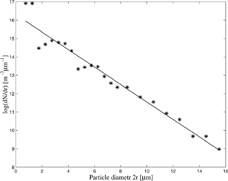
Correlation coefficients between ln(n(2r)) and 2r obtained from the linear regression calculations were high, with average value of R = 0.84. Almost half of the investigated distributions (48%) had correlation coefficients higher than r = 0.9. Only a few had coefficients lower than 0.5. Correlation coefficients are shown in . Thus further analyses were made on the size distributions approximated with formula (2). Such an approach simplifies calculations and eliminates the errors concerned with the Mie resonance, which cause significant peaks of the values in the first several counter channels ().
FIG. 4 Correlation coefficient between the logarithm of particle size spectrum ln(n(2r)) and particle diameter (2r).
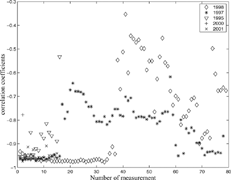
To find the relations between the size distribution and local physical conditions, coefficients a and b were correlated with meteorological parameters such as: wind speed, air temperature, water temperature, difference between water, and air temperature. It was found out that the only essential correlation occurs with wind speed. Only b coefficient from formula (2) was well correlated, while a varied within a small range independently from meteorological conditions.
The relationship between coefficient b and wind speed for data from all cruises is shown in . It can be seen that b can be approximated by linear wind function
FIG. 6 Relationship between logarithm of size distribution amplitude (coefficient b) and wind speed.
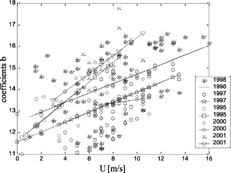
shows coefficient a as a function of wind speed U 10. It is clear that a does not depend on U 10 and it can be assumed to be constant. The mean value of a calculated from the author's data sets was a = −0.29 with a standard deviation of std = 0.14.
Finally, it may be stated that the investigated size distributions may be described as a function of wind speed given by the following formula:
Unfortunately, equation (Equation4) is not the same for all data sets. Coefficients B 1and B 2 have different values in individual measurement series. shows coefficients b and straight lines approximations based on these coefficients. These lines have different slopes. It is therefore hard to determine a universal value of the coefficient b. Despite the fact that for some data sets (cruises), b coefficients correlate well with wind speed U 10, for example data from 1995: R = 0.85 or from 2001: R = 0.62, for the whole data set, this correlation is poor.
shows a straight line approximation function b = B 1 U 10+ B 2 calculated using the whole data set (line with stars indicate 50% error); where B 1 = 0.21 and B 2 = 12.3.
FIG. 7 Relationship between logarithm of size distribution amplitude (coefficient b) and wind speed using all available data. Black line fitted by linear regression, red line-50% error.
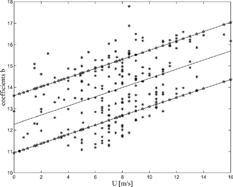
Summing up, using the collected data, coarse aerosol sizes distributions in the near water layer in investigated region may be calculated using the following formula:
Correlation coefficient between the wind speed and data used to calculate parameters B 1 and B 2 in formula (5) was R = 0.46. Thus the dependence (5) explains only 21% of the measured concentrations. On the other hand, it is statistically very significant and thus the probability that it is correct is very high. The dependence (5), as an obtained from a long time series can be treated as a result of an averaging based on ergodicity and can be treated as a result of spatial averaging and thus free of advection factor.
The results presented in and may explain significant distribution of the source function values, obtained using the aerosol concentration measurements during different experiments. shows that the amplitude of size distributions n(2r) may vary up to one order of magnitude due to wind speed variability while its estimation confidence level is not better than two orders of magnitude. Thus the determination of a source function from a single measurement or a series of measurements (see ) may lead to serious errors, which can reach two orders of magnitude.
The errors resulting from using the aerosol concentrations are result from the fact that aerosol concentration near the sea surface is determined not solely by the vertical aerosol fluxes. An advection component plays a very important role in creating aerosol concentration. Even under the conditions when horizontal homogeneity conditions of the studied layer can be assumed as well as the stationary process conditions, the aerosol vertical fluxes can be balanced only with an accuracy determined to within the addition of an arbitrary constant value (from transport equation follows the balance of flux gradients, not the fluxes themselves). One should remember that the spatial scales at which given area may be seen as horizontally homogeneous for small aerosol particles are much bigger than synoptic scales for the wind field (CitationPetelski 2003). This is the reason why the correlation between aerosol concentration and local wind speed is worse for small particles. gives coefficients of aerosol correlation with wind speed at individual size ranges. It can be seen that the concentration of particles of radii smaller than r = 0.5 μm is not correlated with wind speed, and thus it is also not correlated with local emission conditions. The best correlation was observed for particles of radii 1–2 μ m (), smaller particles are less correlated with local conditions. For particles smaller than r = 0.5 μ m correlation coefficient is R = 0.35. It is due to small deposition velocities, and therefore long distances of these particles' transportation. For big particles of radius r > 5 μm the correlation coefficient decreases. This is due to poor number statistics for large particles.
FIG. 8 Mean correlation coefficient between particle concentration and wind speed as a function of particle diameter (2r).
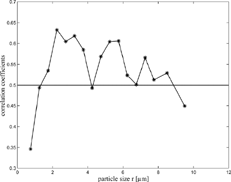
In summary, the dependence (5) obtained from a long series may be used to determine the aerosol source function characteristic for Nordic seas region. It must be kept in mind, though that this is a first approximation. However, since the uncertainties of these function values reach several orders of magnitude (CitationAndreas 2001), it is worth deriving such a function which could become a reference function for further derivations. Especially, since more direct methods of aerosol flux determinations, such as eddy correlation and gradient method, can be applied only in situations when a horizontal homogeneity condition is fulfilled.
4. CONCLUSIONS
The analyses of the measurement results show that the local emission is not always the most important factor that influences the composition of marine aerosol in near water atmospheric layer, even for the coarse mode aerosols, also known as the sea salt mode.
This makes it impossible to derive emission basing on aerosol measurements at one level only using the dry deposition methodology. The method when used for single experiment data can yield results with two orders of magnitude uncertainty.
At the same time it has been determined that the coarse aerosol size distributions in the near water atmospheric layer in European Arctic Seas region are generally described by exponential function r. Using data from several years of campaigns, a formula of aerosol concentration as a function of wind speed was derived that made it possible to calculate the sea spray generation function. Because the function is based on average values of many years, the result is free of inhomogeneity and nonstationarity which are always possible for particulate single experiment data.
It was revealed that the concentration of particles of radius 2–4 μ m is best correlated with wind speed. Hence, this range of aerosol particle sizes should be the subject of studies of aerosol emission from the sea surface.
REFERENCES
- Andreas , E. L. 2001 . “ A Review of the Sea Spray Generation Function for the Open Ocean ” . In Atmospheric-Ocean Interactions , Edited by: Perrie , W. Vol. 1 , 1 – 46 . Southhampton, Boston : WIT Press .
- Andreas , E. L. 1992 . Sea Spray and Turbulent Air-Sea Heat Fluxes . J. Geophys. Res. , 97 ( C7 ) : 11, 429 – 11, 441 .
- Blanchard , D. C. 1954 . Bursting of Bubbles at an Air-Water Interface . Nature , 173 : 104
- Blanchard , D. C. 1989 . The Size and Height to Which Jet Drops Are Ejected From Bursting Bubbles in Seawater . J. Geophys. Res. , 94 ( C8 ) : 10, 999 – 11, 002 .
- Borisenkov , E. P. 1973 . Some Mechanisms of Atmosphere—Ocean Interaction under Stormy Weather Conditions . Problems Arctic and Antactic. , 43–44 : 73 – 83 .
- Bortkovskii , R. S. 1972 . About the Mechanisms of Air-Sea Interactions under the Stormy Conditions . Trudy G.G.O , 282 : 187 – 192 . in Russian
- Bortkovskii , R. S. 1987 . Air-Sea Exchange of Heat and Moisture during Storms , Dordrecht, , The Netherlands : Kluwer Academic Group .
- Cipriano , R. J. , Blanchard , D. C. , Hogan , A. W. and Lala , G. G. 1983 . On the Production of Aitken Nuclei from Breaking Waves and Their Role in the Atmosphere . J. Atmos. Sci. , 40 ( 2 ) : 469 – 478 . [CSA] [CROSSREF]
- Edson , J. B. , Anquentin , S. , Mestayer , P. G. and Sini , J. F. 1996 . Spray Droplet Modeling 2. An Interactive Eulerian—Lagrangian Model of Evaporating Spray Droplets . J. Geophys. Res. , 101 : 1,279 – 1,293 . [CROSSREF]
- Fairall , C. W. , Davidson , K. L. and Schacher , G. N. 1983 . An Analysis of Surface Production of Sea-Salt Aerosols . Tellus , 35B : 31 – 39 .
- Fitzgerald , J. W. 1975 . Approximation Formulas for the Equilibrium Size of an Aerosol Particle as a Function of its Dry Size and Composition and the Relative Humidity . J. Appl. Meteorol , 14 : 1,044 – 1,049 . [CROSSREF]
- Gathman , S. G. 1983 . Optical Properties of Marine Aerosol as Predicted by the Navy Aerosol Model . Optical Engineering , 22 ( 1 ) : 057 – 062 (January/February 1983) .
- Jensen , D. R. , Gathman , S. G. , Zeisse , C. R. , McGrath , C. P. , de Leeuw , G. , Smith , M. H. , Frederickson , P. A. and Davidson , K. 2001 . Electro-Optical Propagation Assessment in Coastal Environments (EOPACE): Summary and Accomplishments . Optical Engineering , 40 ( 8 ) August [CROSSREF]
- Koponen , I. K. , Virkkula , A. , Hillamo , R. and Kulmala , M. 2000 . Aerosol Particle Size Distribution and Total Concentration Measurements from The English Channel to Queen Maud Land Antarctica . Aerosol Sci. , vol 31 ( suppl. I ) : S704 – S705 . [CROSSREF]
- De Leeuw , G. , Neele , F. P. , Hill , M. K. , Smith , M. H. and Vignati , E. 2000 . Production of Sea Spray Aerosol in the Surf Zone . J. Geophys Res. , 105 ( D2 ) : 29397 – 29409 . [CSA] [CROSSREF]
- Mestayer , P. G. , Edson , J. B. , Fairal , C. W. , Larsen , S. E. and Spiel , D. E. 1989 . “ Turbulent Transport and Evaporation of Droplets Generated at an Air-Water Interface. Turbulent Shear Flows 6 ” . Edited by: Andre , J. C. , Cousteix , J. , Durst , F. , Landauer , B. E. , Schmidt , F. W. and Whitelaw , J. H. 129 – 147 . Springer-Verlag .
- Monahan , E. C. , Spiel , D. E. and Davidson , K. L. 1982 . Whitecap Aerosol Productivity Deduced from Simulation Tank Measurements . J. Geophys. Res. , 87 : 8898 – 8904 .
- Petelski , T. 1986 . Impact of Droplet Emissions from the Sea Surface on a Thermal Structure of the Near-Water Layer—Model Concept SIMO . 50 : 63 – 84 . in Polish
- Petelski , T. 1996 . Emission of Sea Sprays and Heat Exchange between the Sea and Atmosphere . Water Resources , 23 ( 2 ) : 145 – 148 .
- Stramska , M. and Petelski , T. 2003 . Observations of Oceanic Whitecaps in the North Polar Waters of the Atlantic . J. Geophys. Res. , 108 ( C3 ) [CSA] [CROSSREF]
- van Eijk Alexander , M. J. and de Leeuw , G. 1992 . Modeling Aerosol Particle Size Distributions Over the North Sea . J. Geophys. Res. , 97 ( C9 ) : 14417 – 14429 . [CSA]
- Vignati , E. , de Leeuw , G. and Berkowicz , R. 2001 . Modeling Coastal Aerosol Transport and Effects of Surf-Produced Aerosols on Processes in the Marine Atmospheric Boundary Layer, 2001 . J. Geophys. Res. , 106 ( D17 ) : 20,225 – 20,238 . [CROSSREF]
- Wiedensohler , A. and Covert , D. S. 1996 . Number Concentration and Size Distributions of Atmospheric Aerosol under Baseline Condition at Cape Grim . J. Aerosol Sci. , 27 ( I ) : S99 – S100 . [CSA] [CROSSREF]
- Wu , J. 1973 . Spray in the Atmospheric Surface Layer: Laboratory Study . J. Geophys. Res. , 78 : 511 – 519 .
- Zielinski , T. , Zielinski , A. , Piskozub , J. , Drozdowska , V. and Irczuk , M. 1999 . Aerosol Optical Thickness Over the Coastal Area of the Southern Baltic Sea . Optica Applicata , 29 ( 4 ) : 439 – 447 .
- Zieliński , T. 2004 . Studies of Aerosol Physical Properties in Coastal Areas . Aerosol Sci & Technol. , 38 ( 5 ) : 513 – 524 . [CROSSREF]
